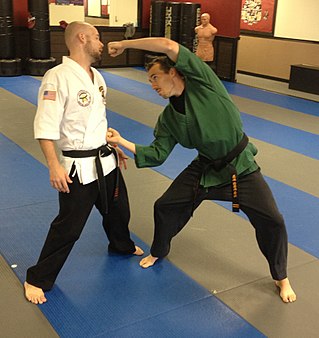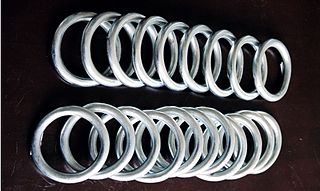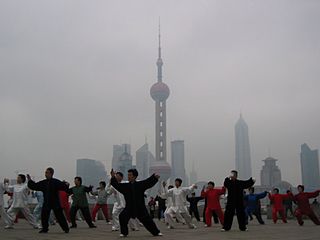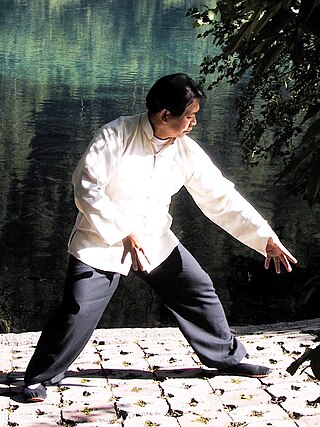Related Research Articles

Neijia is the collective name for the internal Chinese martial arts. It relates to those martial arts occupied with spiritual, mental or qi-related aspects, as opposed to an "external" approach focused on physiological aspects. The distinction dates to the 17th century, but its modern application is due to publications by Sun Lutang, dating to the period of 1915 to 1928. Neijing is developed by using neigong or "internal changes", contrasted with waigong or "external exercises".

Shaolin kung fu, also called Shaolin Wushu, or Shaolin quan, is one of the oldest, largest, and most famous styles of wushu, or kung fu of Chan Buddhism. It combines Chan philosophy and martial arts. It was developed in the Shaolin Temple in Henan province, Greater China during its 1500-year history. Popular sayings in Chinese folklore related to this practice include "All martial arts under heaven originated from Shaolin" and "Shaolin kung fu is the best under heaven," indicating the influence of Shaolin kung fu among martial arts. The name Shaolin is also used as a brand for the so-called external styles of kung fu. Many styles in southern and northern China use the name Shaolin.

Kenpō is the name of several arts. This term is often informally transliterated as "kempo", as a result of applying Traditional Hepburn romanization, but failing to use a macron to indicate the long vowel. The word Kenpō translates thus: "Ken" meaning 'Fist' and "Po" meaning 'Method' or 'Law' as in 'Law of gravity', a correct interpretation of the word Kenpō would be 'Fist Method', the same meaning as 'Quanfa'. However, it is often misinterpreted as 'the Law of the Fist'. The generic nature of the term combined with its widespread, cross-cultural adoption in the martial arts community has led to many divergent definitions.
Kajukenbo is a hybrid martial art from Hawaii. It was developed in the late 1940s and founded in 1947 in the Palama Settlement on Oahu, Territory of Hawaii.
The following outline is provided as an overview of and topical guide to martial arts:

Dantian is a concept in traditional Chinese medicine loosely translated as "elixir field", "sea of qi", or simply "energy center". Dantian are the "qi focus flow centers", important focal points for meditative and exercise techniques such as qigong, martial arts such as tai chi, and in traditional Chinese medicine.
Neigong, also spelled nei kung, neigung, or nae gong, refers to a series of internal changes that a practitioner goes through when following the path to Dao, and these changes may be achieved through practices including qigong or tai chi. Neigong is also associated with xingyi quan.

Fujian White Crane, also known as White Crane Style is a Southern Chinese martial art that originated in Yongchun County, Fujian (福建) province. According to oral tradition, the style was developed by Fang Qiniang, a female martial artist. It is associated with traditional fighting techniques, including long range, but is most similar to close-quarter or hand-to-hand combat. It is most recognizable by the way the fighter imitates a bird's pecking or flapping of wings. While some white crane styles make use of traditional weapons, others have discontinued the use of weaponry.
Reverse breathing is a breathing technique associated with qigong and martial arts. It consists of compressing the abdomen while inhaling through the mouth, and expanding it while exhaling through the nose. Practitioners believe that consciously controlling this movement in a way opposite to normal breathing can build up qi for various applications.

Ziranmen, also known as Natural Boxing, is a Northern internal style of kung fu that is taught in conjunction with qigong breathing techniques. The style traces its lineage to Dwarf Xu, who based it on ancient Taoist philosophy. Du Xinwu, the next bearer of the lineage, served as a bodyguard to Sun Yat-sen, then the provisional president of the Republic of China. Du imparted his knowledge of "Natural Boxing" to his eldest son Du Xiusi and Wan Laisheng, a prominent twentieth century martial artist.
Hybrid martial arts, also known as hybrid fighting systems or sometimes eclectic martial arts or freestyle martial arts, referred to as mixed martial arts or fighting systems that incorporate techniques and theories from several martial arts. While numerous martial arts borrow or adapt from other arts and to some extent could be considered hybrids, a hybrid martial art emphasizes its disparate origins.
George Dillman is a controversial American martial arts instructor, who popularized the use of techniques such as pressure points among the United States' martial arts practitioners. Dillman is a member of Black Belt magazine's Hall of Fame, and in 1997 was named Black Belt Magazine's "Martial Arts Instructor of the Year". For 30 years, he ran the Northeast Karate Championships. Dillman also conducts martial arts training seminars at the former Muhammad Ali training camp at Deer Lake, Pennsylvania. Dillman has been subject to scrutiny stemming from the fact that many of his most famous techniques don't work, especially those involving alleged touchless chi manipulation.

There are hundreds of different styles of Chinese martial arts, each with their own sets of techniques and ideas. The various movements in kung fu, most of which are imitations of the fighting styles of animals, are initiated from one to five basic foot positions: normal upright posture and the four stances called dragon, frog, horse riding, and snake.

Bruce Kumar Frantzis is a Taoist educator who studied Taoism in China.

Qigong, is a system of coordinated body-posture and movement, breathing, and meditation said to be useful for the purposes of health, spirituality, and martial arts training. With roots in Chinese medicine, philosophy, and martial arts, qigong is traditionally viewed by the Chinese and throughout Asia as a practice to cultivate and balance the mythical life-force qi.

Doc-Fai Wong is a master of tai chi and the Hung Sing branch of Choy Li Fut kung fu. He was born in 1948 in the Guangdong province of China, specifically, the Wangshan village in the Doumen District of Zhuhai. In April 1960, he and his mother immigrated to San Francisco, California to be reunited with his father. He arrived as a third-generation citizen of the United States of America since both his grandfather and father were already citizens. He sought out his first kung fu teacher - Lau Bun (劉彬), the founder of the first Hung Sing Kwoon of Choy Li Fut in America, after encountering taunting and bullying due to language and ethnic difficulties after his arrival. When Lau Bun died in 1967, he started teaching and opened his first school when he was 19 years old.

Shaolin Kenpo Karate is a martial art style that combines the Five Animals of Shaolin Kung Fu (Shaolinquan), the core competency of Kempo, the hard-hitting linear explosiveness of traditional Karate, as well as the power of Western boxing and the felling and grappling arts of Jujutsu, Chin Na, and Mongolian wrestling. This system was founded and developed by Fredrick J. Villari, who devised a hybrid system which integrated the four ways of fighting: striking, kicking, felling, and grappling to eliminate the inherent weakness of martial arts systems that focus on just one or two of fighting techniques.

Wudangquan is a class of Chinese martial arts. In contemporary China, Chinese martial arts styles are generally classified into two major groups: Wudang (Wutang), named after the Wudang Mountains; and Shaolin, named after the Shaolin Monastery. Whereas Shaolin includes many martial art styles, Wudangquan includes only a few arts that use the focused mind to control the body. This typically encompasses tai chi, xingyiquan and baguazhang, but must also include bajiquan and Wudang Sword. Although the name Wudang simply distinguishes the skills, theories and applications of the internal arts from those of the Shaolin styles, it misleadingly suggests these arts originated at the Wudang Mountains. The name Wudang comes from a popular Chinese legend that incorrectly purports the genesis of tai chi and Wudang Sword by an immortal, Taoist hermit named Zhang Sanfeng who lived in the monasteries of Wudang Mountain. Wudang quan is often used synonymously with Neijia, but Neijia is a broader term that also encompasses Aikido and Qigong, which are not Wudang quan.
Wujiquan, known as the "Ultimate Void Boxing" or "A Rare and Secret Ultimate Void Boxing Skill" and "Mother Art of Tai Chi," is a Chinese martial art. It is a traditional system composed of 36 "Characters" divided into 18 kinds of natural climatic phenomena and 18 of Qi applications.
Qigong, the Chinese practice of aligning breath, movement, and awareness for exercise, healing, and martial arts training, has a history that extends back more than 4,000 years. Contemporary qigong is a complex accretion of the ancient Chinese meditative practice xingqi or "circulating qi" and the gymnastic breathing exercise daoyin or "guiding and pulling", with roots in the I Ching and occult arts; philosophical traditions of Confucianism, Taoism, and Buddhism, traditional Chinese medicine and martial arts; along with influences of contemporary concepts of health, science, meditation, and exercise.
References
- ↑ Kenko (health) Kempo (fist) Karate (empty hand)
- ↑ Nederlandse Federatie voor Krijgskunsten
- ↑ Erich B. Ries, S. Wogawa. Kenko Kempo Karate. Gesundheitssport, Kampfkunst, Selbstverteidigung. Erfurt: Eobanus Verlag; 2011; ISBN 978-3-9814241-3-3
- ↑ "Großmeister Erich B. Ries | Kenko Kempo Karate Organisation e.V."
- ↑ "Nuevo – News – Neu".
- ↑ Erich B. Ries, Stefan Wogawa. Kenko Kempo Karate – Selbstverteidigung für Senioren. Das Konzept für Gesundheitssport, Kampfkunst, Selbstverteidigung. Aktualisierte und erweiterte Neuausgabe. Norderstedt: BoD; 2016; ISBN 978-3741-2653-41
- ↑ Thüringer Algemeine, December 13, 2019; Schonende Kampfkunst in Magdala.https://www.thueringer-allgemeine.de/regionen/weimar/schonende-kampfkunst-in-magdala-id227909323.html
- ↑ NWZ Online: Nachrichten aus Oldenburg, February 3, 2021; Doris Grove-Mittwede. Jahrzehntelang noch 50 bleiben.https://mobil.nwzonline.de/plus-ammerland/apen-gesundheit-in-apen-jahrzehntelang-noch-50-bleiben%20a%2050,12,243560068.html
- ↑ "Mitglieder | Kenko Kempo Karate Organisation e.V."
- 1 2 E.B. Ries, S. Wogawa. KENKO KEMPO KARATE®. Stiloffene Kampfkunst für Senioren und Menschen mit Handicap. Das Beste aus QiGong, Tai-Chi-Chuan, Karate und Gesundheitsgymnastik. Das vollständige Programm bis zum 3. Dan. Für Einsteiger, Quereinsteiger und Wiedereinsteiger in die Kampfkünste. Open Style Martial Arts for Seniors and People with Disabilities. The best of QiGong, Tai-Chi-Chuan, Karate and health gymnastics. The full program up to 3rd dan. For the new-comer, career changer and those returning to martial arts. Norderstedt: BoD 2022; ISBN 978-3-7543-5949-5
- ↑ "KENKO KEMPO KARATE - kampfkunst-igensdorf". Kampfkunst-igensdorf.de. Retrieved 2022-06-03.
- ↑ "Home - kenkokempokarate-chiemgau-des Webseite!". Kenkokempokarate-chiemgau-de.jimdofree.com. Retrieved 2022-06-03.
- ↑ "Kenko Kempo Karate". Yoshin-ryu.online. 1970-01-01. Retrieved 2022-06-03.
- ↑ "Hohe Auszeichnung für Shifu Martin Wolf".
- ↑ "KKKO/Vitale ouderen door Krijgskunst – Thijssen Taekwon-Do Academie".
- ↑ "KENKO KEMPO KARATE | Detlef Schroeder Kenko Kempo Karate Wangerooge".
- ↑ "9er/NeunerYang-Tai-Chi-Form aus dem Kenko Kempo Karate". YouTube .
- ↑ "Kenko Kempo Kata". YouTube .
- ↑ Erich B. Ries, S. Wogawa. Kenko Kempo Karate. Gesundheitssport, Kampfkunst, Selbstverteidigung. Erfurt: Eobanus Verlag; 2011; ISBN 978-3-9814241-3-3